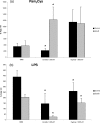Modulation of Toll-like receptor 2 (TLR2) and TLR4 responses by Aspergillus fumigatus
- PMID: 19204090
- PMCID: PMC2681752
- DOI: 10.1128/IAI.01455-08
Modulation of Toll-like receptor 2 (TLR2) and TLR4 responses by Aspergillus fumigatus
Abstract
Toll-like receptor (TLR)-based signaling pathways in the host may be modulated by pathogens during the course of infection. We describe a novel immunomodulatory mechanism in which Aspergillus fumigatus conidia induce attenuation of TLR2- and TLR4-mediated interleukin (IL)-6 and IL-1beta proinflammatory responses in human mononuclear cells with suppression of IL-1beta mRNA transcription. Background TLR2 and TLR4 mRNA transcription was not influenced. A. fumigatus conidia induced TLR2 internalization and uptake into the phagosome with a resultant decrease in surface receptor expression. A. fumigatus hyphae, on the other hand, selectively downregulated the TLR4-mediated response. These novel immunosuppressive effects may facilitate the invasiveness of A. fumigatus.
Figures






Similar articles
-
Triggering of toll-like receptors 2 and 4 by Aspergillus fumigatus conidia in immortalized human corneal epithelial cells to induce inflammatory cytokines.Chin Med J (Engl). 2008 Mar 5;121(5):450-4. Chin Med J (Engl). 2008. PMID: 18364120
-
Innate responses of corneal epithelial cells against Aspergillus fumigatus challenge.FEMS Immunol Med Microbiol. 2009 Jun;56(1):88-93. doi: 10.1111/j.1574-695X.2009.00551.x. Epub 2009 Apr 1. FEMS Immunol Med Microbiol. 2009. PMID: 19341426
-
The IL-36 receptor pathway regulates Aspergillus fumigatus-induced Th1 and Th17 responses.Eur J Immunol. 2013 Feb;43(2):416-26. doi: 10.1002/eji.201242711. Epub 2012 Dec 18. Eur J Immunol. 2013. PMID: 23147407
-
TLR2, but not TLR4, triggers cytokine production by murine cells in response to Candida albicans yeasts and hyphae.Microbes Infect. 2006 Jul;8(8):2299-304. doi: 10.1016/j.micinf.2006.03.014. Epub 2006 Jun 5. Microbes Infect. 2006. PMID: 16782386 Review.
-
Immune responses to Aspergillus fumigatus infections.Biol Blood Marrow Transplant. 2006 Jan;12(1 Suppl 1):47-9. doi: 10.1016/j.bbmt.2005.09.007. Biol Blood Marrow Transplant. 2006. PMID: 16399584 Review.
Cited by
-
Toll-like receptor 4 signaling leads to severe fungal infection associated with enhanced proinflammatory immunity and impaired expansion of regulatory T cells.Infect Immun. 2010 Mar;78(3):1078-88. doi: 10.1128/IAI.01198-09. Epub 2009 Dec 14. Infect Immun. 2010. PMID: 20008536 Free PMC article.
-
Trichophyton rubrum Elicits Phagocytic and Pro-inflammatory Responses in Human Monocytes Through Toll-Like Receptor 2.Front Microbiol. 2019 Nov 21;10:2589. doi: 10.3389/fmicb.2019.02589. eCollection 2019. Front Microbiol. 2019. PMID: 31824444 Free PMC article.
-
TLR9 activation dampens the early inflammatory response to Paracoccidioides brasiliensis, impacting host survival.PLoS Negl Trop Dis. 2013 Jul 25;7(7):e2317. doi: 10.1371/journal.pntd.0002317. Print 2013. PLoS Negl Trop Dis. 2013. PMID: 23936560 Free PMC article.
-
Differential Interactions of Serum and Bronchoalveolar Lavage Fluid Complement Proteins with Conidia of Airborne Fungal Pathogen Aspergillus fumigatus.Infect Immun. 2020 Aug 19;88(9):e00212-20. doi: 10.1128/IAI.00212-20. Print 2020 Aug 19. Infect Immun. 2020. PMID: 32571987 Free PMC article.
-
Proteome and Dihydrorhodamine Profiling of Bronchoalveolar Lavage in Patients with Chronic Pulmonary Aspergillosis.J Fungi (Basel). 2024 Apr 25;10(5):314. doi: 10.3390/jof10050314. J Fungi (Basel). 2024. PMID: 38786669 Free PMC article.
References
-
- Bellocchio, S., C. Montagnoli, S. Bozza, R. Gaziano, G. Rossi, S. S. Mambula, A. Vecchi, A. Mantovani, S. M. Levitz, and L. Romani. 2004. The contribution of the Toll-like/IL-1 receptor superfamily to innate and adaptive immunity to fungal pathogens in vivo. J. Immunol. 1723059-3069. - PubMed
-
- Bennett, J. E., M. M. Friedman, and B. Dupont. 1987. Receptor-mediated clearance of Aspergillus galactomannan. J. Infect. Dis. 1551005-1010. - PubMed
-
- Chieppa, M., G. Bianchi, A. Doni, A. Del Prete, M. Sironi, G. Laskarin, P. Monti, L. Piemonti, A. Biondi, A. Mantovani, M. Introna, and P. Allavena. 2003. Cross-linking of the mannose receptor on monocyte-derived dendritic cells activates an anti-inflammatory immunosuppressive program. J. Immunol. 1714552-4560. - PubMed
Publication types
MeSH terms
Substances
LinkOut - more resources
Full Text Sources

